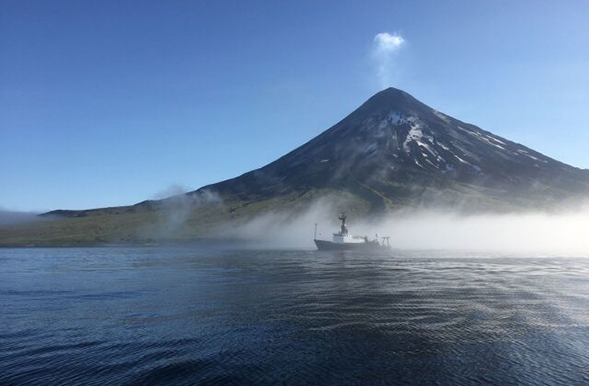Dispatches from the Aleutian Islands
A team of SDSU scientists provides a first-hand account of their investigation into Pacific Ocean kelp forests.

This summer, SDSU ecology professor Matthew Edwards is leading a research expedition to the Aleutian Islands, Alaska to study its kelp forests and the wildlife within. This is the first in a series of field notes that students on the trip will be providing. The project is funded by the National Science Foundation.
After nine hours of flying, finally we walked out onto the tarmac at Adak Island. Immediately, we were nearly pushed over by 30 mph winds.
“Welcome back to the Aleutians," we thought.
Adak, also known as "the birth place of the winds," is in the central part of the Aleutian Archipelago, an island chain that stretches from mainland Alaska to Russia and divides the Pacific Ocean from the Bering Sea.
Characterized by volcanic islands, abundant marine life and unforgiving weather, the Aleutian Archipelago is a unique place. The nearshore rocky reefs have historically been dominated by dense dragon kelp (Eualaria fistulosa) forests. These algae are considered ecosystem engineers because they provide habitat and structure that support a diverse array of marine life.
Dragon kelp, along with associated algae, oxygenate the water via photosynthesis, and provide the base of the food chain for hundreds of species, ranging from mammals such as sea otters and stellar sea lions, to invertebrates such as sea stars and sponges.
While these islands are incredibly remote, they have not escaped the impacts of human activity. From the 1700s through the 1970s, humans have altered this unique island chain. That is why our group of 11 scientists from San Diego State University, the University of Alaska Fairbanks, and South Korea’s Kunsan National University are conducting research here. The R/V Oceanus is our floating home for the next three weeks.
Changes in landscape
In the 1980s, sea otters throughout the Aleutian Islands began to disappear. It is hypothesized that orcas (also known as killer whales) depleted their populations because they were hungry; international whaling in the North Pacific had wiped out their staple food supplies.
As the numbers of otters decreased, the population of their favorite food, green sea urchins, began to explode. This shift in the food chain, known to ecologists as a trophic cascade, resulted in large-scale changes to the underwater landscape of the Aleutians. Sea urchin numbers became so great that they began to essentially "lawn mow" the surrounding kelp forests and associated algae, leaving behind urchin barren grounds.
Over the next 5-10 years, sea urchins consumed thousands of kilometers of kelp forests. The goal of our research is to understand how this immense loss of kelp affects patterns of marine diversity and primary production across the archipelago. To do this, we will sample 11 representative islands (six in 2016, five in 2017) to make inferences about impacts across the archipelago.
We are currently on Day 3 of our expedition, anchored in Constantine Harbor at Amchitka Island. Adjacent to our boat is a pier that was constructed during World War II, but has since been abandoned. One of our dive sites is littered with old ammunition and an airplane wing. The topside weather has been cloudy and grey, but when the winds are not blowing, the calm seas bring out the bright colors of the subtidal world.
Once we depart from Amchitka Island, we will begin our steam to Attu Island, which will take more than 24 hours. During this time, we will be busy sorting through samples collected during dives and offshore trawls, recording data, and hoping for good weather that will give us a smooth transit (which is unlikely). Stay tuned for more field notes in the coming weeks!
Aleutian Islands Research A team of SDSU scientists provides a first-hand account of their investigation into Pacific Ocean kelp forests.



